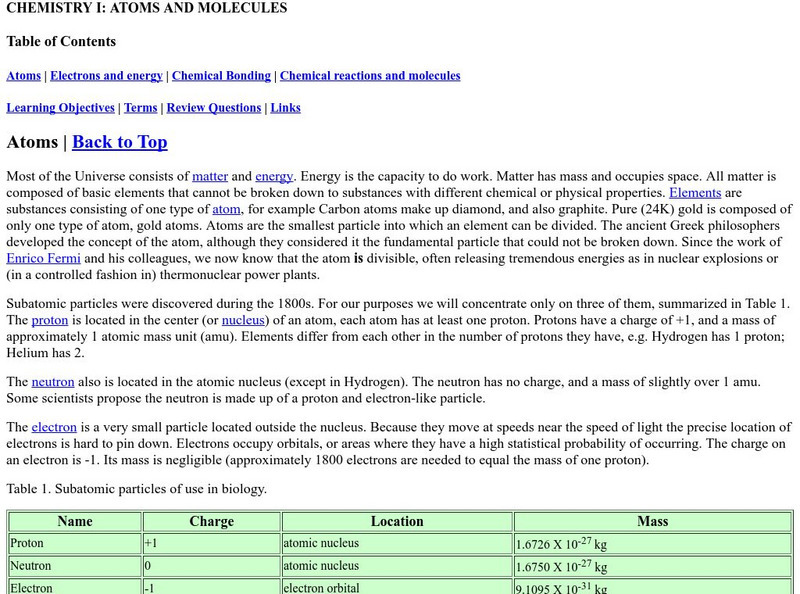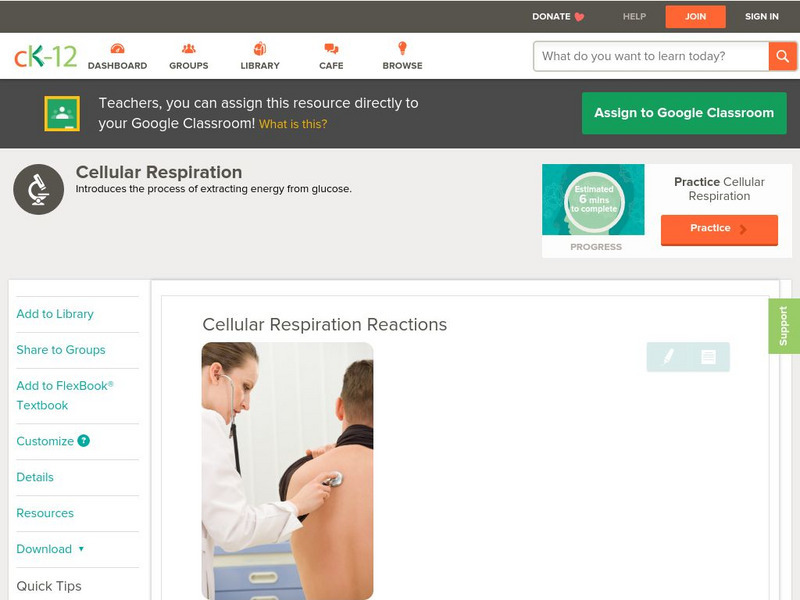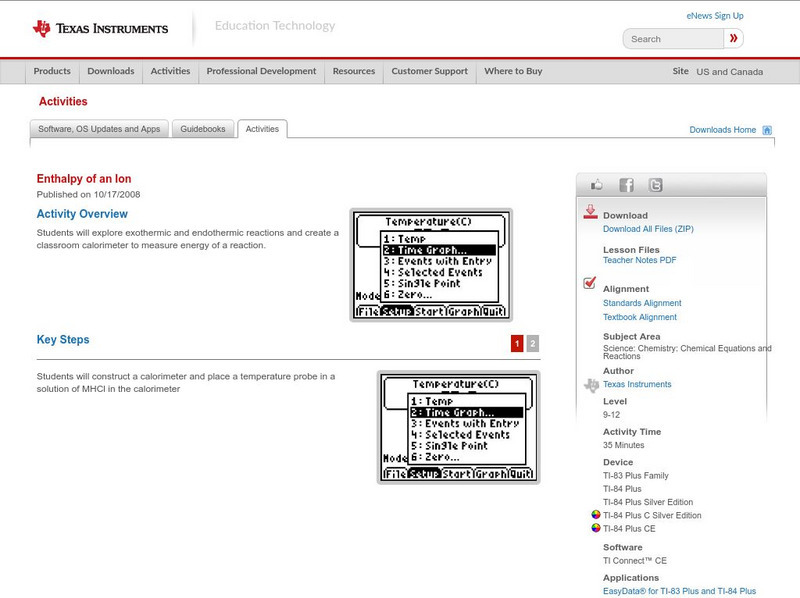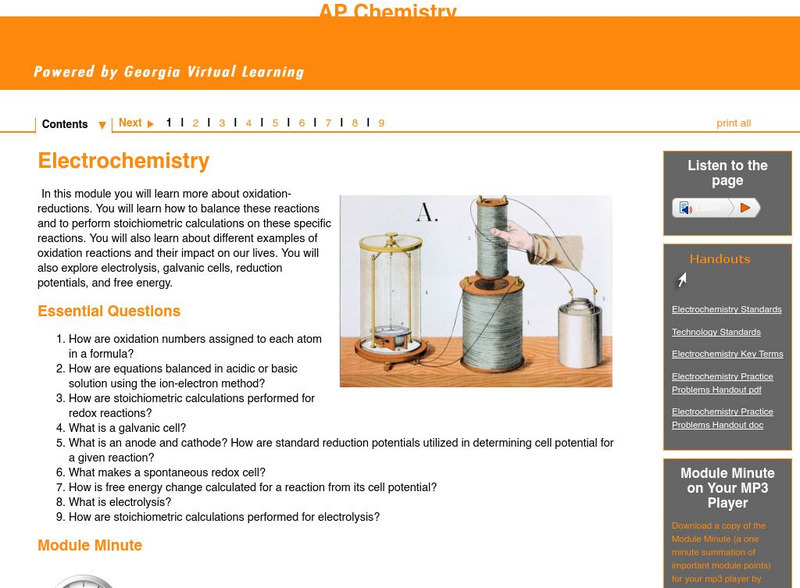Sophia Learning
Sophia: Activation Energy: Lesson 3
This lesson will explain how activation energy is needed to start a chemical reaction. It is 3 of 5 in the series titled "Activation Energy."
Sophia Learning
Sophia: Activation Energy: Lesson 4
This lesson will explain how activation energy is needed to start a chemical reaction. It is 4 of 5 in the series titled "Activation Energy."
Sophia Learning
Sophia: Activation Energy: Lesson 1
This lesson will explain how activation energy is needed to start a chemical reaction. It is 1 of 5 in the series titled "Activation Energy."
Sophia Learning
Sophia: Fission and Fusion: Lesson 3
This lesson will explain how fission and fusion in chemical reactions can be used to produce energy. It is 3 of 4 in the series titled "Fission and Fusion."
TeachEngineering
Teach Engineering: Hydrogen Oxygen Reaction Lab
This lab exercise exposes students to a potentially new alternative energy source-hydrogen gas. Student teams are given a hydrogen generator and an oxygen generator. They balance the chemical equation for the combustion of hydrogen gas...
Khan Academy
Khan Academy: Intro to Photosynthesis
Discussion of the conversion of light energy to chemical energy through the life-sustaining process of photosynthesis. Explores the reactions of photosynthesis, where they take place, and their ecological importance.
PBS
Pbs Learning Media: Fa Qs About Nuclear Power
Nuclear physicist, Dr. Charles Till, answers questions about nuclear power in this interview from the FRONTLINE Web site.
Center of Science and Industry
Cosi Columbus: Sidewalk Chalk
Make your own sidewalk chalk, and learn about chemical reactions. During the procedure, feel the heat as energy is released in an exothermic reaction.
National High Magnetic Field Laboratory
Magnet Academy: Svante Arrhenius
Svante Arrhenius was born in Vik, Sweden, and became the first native of that country to win the Nobel Prize. The award for chemistry was bestowed to him in honor of his theory of electrolytic dissociation. Arrhenius also developed the...
Alabama Learning Exchange
Alex: S'mores Limiting & Excess Reactants
Students will use manipulatives that represent the ingredients for S'mores (graham crackers, marshmallows, chocolate bar) to determine the limiting and excess reactants (reagents) for making S'mores. The students will extend this to...
Science Struck
Science Struck: Endothermic vs. Exothermic Reactions
Explains the differences between endothermic and exothermic reactions and the role thermodynamic potentials play in them. Examples from nature are also provided.
Estrella Mountain Community College
Online Biology Book: Chemistry I: Atoms and Molecules
In this online biology textbook, learn about atoms and molecules as they relate to life. Find out about topics such as electrons and energy, chemical bonding, and chemical reactions.
Concord Consortium
Concord Consortium: Stem Resources: Making and Breaking Bonds
A look at the processes of association and dissociation in chemical bonding. Observe simulations that show the influence of temperature on making and breaking of bonds, how diatomic molecules form, and what determines the speed of...
CK-12 Foundation
Ck 12: Physical Science: Cellular Respiration Reactions
[Free Registration/Login may be required to access all resource tools.] Definition of cellular respiration and its overall chemical equation. The energy changes that occur during cellular respiration, including in photosynthesis.
Texas Instruments
Texas Instruments: Enthalpy of an Ion
In this activity you will: Explore exothemic and endothermic reactions. Create a classroom calorimeter to measure energy of a reaction.
Cosmo Learning
Cosmo Learning: General Chemistry
A collection of video lectures from a general chemistry course taught at the University of California, Berkeley. The course teaches periodic table, chemical bonds, molecular shape, phase changes, chemical reactions, stoichiometry,...
Georgia Department of Education
Ga Virtual Learning: Ap Chemistry: Electrochemistry
In this module students learn more about oxidation-reductions and how to balance these reactions and perform stoichiometric calculations on these specific reactions. Students also explore electrolysis, galvanic cells, reduction...
BiologyWise
Biology Wise: An Overview of the Difference Between Nadh and Nadph
NADH and NADPH are enzymes involved in cellular processes. Explains how NADH participates in catabolic reactions where energy is released and NADPH is involved in anabolic reactions where energy is consumed. Their functions and chemical...
The Franklin Institute
The Franklin Institute Online: Balloon Blow Up
In this simple experiment from the Franklin Institute, students observe the conversion of stored energy into work.
Sophia Learning
Sophia: Catalyst: Lesson 2
This lesson will describe that a catalyst is something which can speed up a reaction by lowering activation energy. It is 2 of 4 in the series titled "Catalyst."
Sophia Learning
Sophia: Catalyst: Lesson 4
This lesson will describe that a catalyst is something which can speed up a reaction by lowering activation energy. It is 4 of 4 in the series titled "Catalyst."
Sophia Learning
Sophia: Catalyst: Lesson 1
This lesson will describe that a catalyst is something which can speed up a reaction by lowering activation energy. It is 1 of 4 in the series titled "Catalyst."
CK-12 Foundation
Ck 12: Life Science: Producers
[Free Registration/Login may be required to access all resource tools.] Energy is the ability to do work. In organisms, this can be physical work, like walking or jumping, or it can be the work used to carry out the chemical processes in...
CK-12 Foundation
Ck 12: Plix Series: Enthalpy
[Free Registration/Login Required] Move the chemical reaction along, and observe the overall change in enthalpy for each reaction in the simulation. After the activity, answer one challenge question to check for understanding.


















